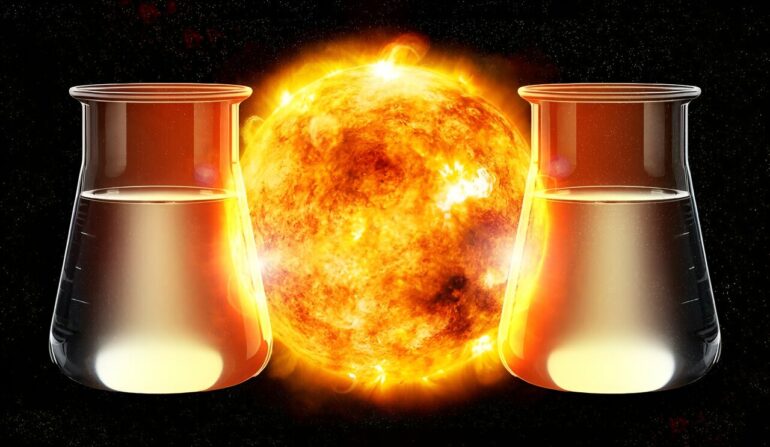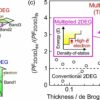The race is on to develop a new generation of liquid fuels that are activated by sunlight, and Yale researchers are helping to lead the way.
Over the past decade, basic research aimed at creating sustainable, solar-powered liquid fuel has reached a crossroads. New semiconductor materials can effectively capture sunlight and catalyze the conversion of carbon dioxide into valuable products, such as liquid fuels. However, it is often challenging to form a single product. Molecular catalysts can form a single product from carbon dioxide (CO2) but are not stable. Consequently, many scientists say neither of those approaches is adequate for large scale production.
But a third methodology is now emerging. Yale chemists involved in the Center for Hybrid Approaches to Solar Energy (CHASE) are combining new semiconductor materials with new molecular catalysts into more powerful, streamlined processes that may be scalable for wider use.
This promising new approach, which is described in two recent studies, represents a “best of both worlds” approach, researchers say, which could lead to game-changing, alternative fuel products that have the added benefit of removing CO2 from the air.
“Both of these papers give me a lot of hope that a hybrid approach can work,” said Eleanor Stewart-Jones, a graduate student in Yale’s Department of Chemistry and co-first author of one of the studies. “We’re definitely finding new ways to improve or enhance reactivity.”
Roughly a dozen Yale faculty members and graduate students are part of CHASE, a federally funded solar energy research hub comprised of six U.S. research institutions and based at the University of North Carolina-Chapel Hill. CHASE’s mission is to accelerate research that may lead to the production of liquid fuels from sunlight, water, nitrogen, and carbon dioxide.
Yale’s contingent includes Nilay Hazari, the John Randolph Huffman Professor of Chemistry; James Mayer, the Charlotte Fitch Roberts Professor of Chemistry; and Hailiang Wang, professor of chemistry, all from the Faculty of Arts and Sciences.
“It has been inspiring to see the dedication that our students, postdoctoral researchers, and our colleagues at partner institutions are bringing to this work,” Wang said. “Each new discovery brings us closer to developing the technology necessary for practical solar fuels.”
Yale’s research ingenuity is front and center in the two new CHASE studies, both published in the Journal of the American Chemical Society. They focus on silicon-based photoelectrodes—the components in solar batteries that draw in sunlight and convert it into electrical energy.
In the first study, led by Wang’s lab at Yale and the lab of Tianquan Lian at Emory University, researchers constructed an electrode consisting of an array of silicon micropillars, coated with a layer of superhydrophobic fluorinated carbon.
This strategy boosted the overall electrode surface area and led to a dramatic rise in catalytic activity. “We saw a remarkable increase, up to 17 times more catalytic activity than the previous record for silicon photoelectrodes,” said Bo Shang, a Yale graduate student in chemistry and co-first author of the study.
The approach yielded the most efficient CO2 photoelectrocatalytic conversion of sunlight to methanol, based on silicon, ever reported. Methanol is a colorless, alternative liquid fuel.
For the second study, the Yale labs of Mayer and Hazari collaborated on a process involving thin wafers of porous silicon, a form of silicon that is etched with channels called nanopores. The researchers attached a molecular rhenium catalyst to these electrode wafers.
“To our knowledge, this is the first time anyone has attached a molecular catalyst to porous silicon,” said Stewart-Jones, a graduate student in Mayer’s lab and co-first author of the study.
The resulting chemical reaction, sparked by sunlight, transforms CO2 into carbon monoxide in a more consistent and reproducible manner than when molecular catalysts are paired with flat, non-porous silicon.
“We have successfully immobilized an effective molecular CO2 reduction catalyst onto a sunlight-absorbing silicon material,” said Xiaofan Jia, a postdoctoral researcher in the Hazari lab and the study’s other co-first author. “This enables the device to directly utilize energy from sunlight to produce fuels.”
Taken together, both studies highlight the diversity and creativity of the CHASE project, Wang said.
“These two works both develop CO2 reduction photoelectrodes with silicon and a molecular catalyst, but take very different approaches,” Wang said.
More information:
Bo Shang et al, Tailoring Interfaces for Enhanced Methanol Production from Photoelectrochemical CO2 Reduction, Journal of the American Chemical Society (2024). DOI: 10.1021/jacs.3c13540 Xiaofan Jia et al,
Photoelectrochemical CO2 Reduction to CO Enabled by a Molecular Catalyst Attached to High-Surface-Area Porous Silicon, Journal of the American Chemical Society (2024). DOI: 10.1021/jacs.3c10837
Citation:
Sun, sustainability, and silicon: A double dose of solar fuel research (2024, May 17)



